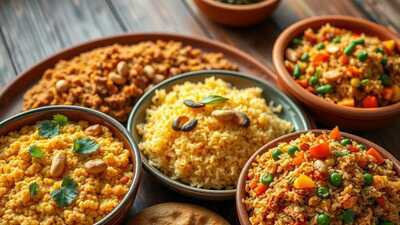Indian cuisine is rich in flavors, tradition, and variety. While many dishes are rooted in wholesome ingredients, some commonly eaten desi foods can quietly contribute to weight gain. What makes it tricky is that these items often seem harmless or even healthy when consumed in moderation. However, hidden calories, excessive carbs, sugars, and oils in everyday staples can lead to gradual fat accumulation—especially if paired with a sedentary lifestyle.
Overuse of Ghee and Oil
Ghee and oil are often praised in Indian kitchens for their taste and Ayurvedic benefits. However, when used in large amounts—for tadkas, parathas, puris, or deep-frying—they become dense sources of saturated fats and calories. One tablespoon of ghee alone contains about 120 calories. Over time, this excess fat intake can lead to weight gain and higher cholesterol levels if not balanced with physical activity.

White Rice and Refined Wheat Rotis
White rice and regular atta (refined wheat flour) rotis are staples in most Indian meals. While comforting and filling, they are also high-glycemic carbs that spike blood sugar quickly and convert to fat if eaten in excess. Pairing rice or multiple rotis without enough vegetables or proteins can increase fat storage—particularly around the belly.
Pickles, Papads, and Chutneys
Pickles (achars), papads, and spicy chutneys are tasty additions, but they’re often loaded with salt, oil, and preservatives. These condiments stimulate appetite, cause water retention, and sometimes encourage overeating. Eating these every day—even in small amounts—can quietly contribute to both bloating and long-term weight gain.
Sweetened Tea and Bakery Biscuits
The classic chai-biscuit combo seems innocent but can be deceiving. Many people consume tea with added sugar 2–3 times a day, along with refined flour biscuits that are low in nutrients and high in empty calories. These snacks quickly add up and promote fat storage, especially if there’s little physical movement throughout the day.
Indian Sweets and Festive Foods
Traditional sweets like ladoos, jalebis, and barfis are rich in refined sugar, ghee, and khoya—ingredients that are extremely calorie-dense. Leftover sweets after festivals or daily indulgence in small mithai can contribute to slow and steady weight gain. Even homemade sweets can pose risks if portion sizes aren't controlled.
Supporting Study
A 2020 study published in the Indian Journal of Endocrinology and Metabolism found that traditional Indian diets high in carbohydrates and saturated fats—especially when not balanced with fiber or protein—significantly increased the risk of obesity and insulin resistance in urban Indian adults. The study emphasized the need for portion control and mindful eating, even with homemade or familiar foods.
Overuse of Ghee and Oil
Ghee and oil are often praised in Indian kitchens for their taste and Ayurvedic benefits. However, when used in large amounts—for tadkas, parathas, puris, or deep-frying—they become dense sources of saturated fats and calories. One tablespoon of ghee alone contains about 120 calories. Over time, this excess fat intake can lead to weight gain and higher cholesterol levels if not balanced with physical activity.
White Rice and Refined Wheat Rotis
White rice and regular atta (refined wheat flour) rotis are staples in most Indian meals. While comforting and filling, they are also high-glycemic carbs that spike blood sugar quickly and convert to fat if eaten in excess. Pairing rice or multiple rotis without enough vegetables or proteins can increase fat storage—particularly around the belly.
Pickles, Papads, and Chutneys
Pickles (achars), papads, and spicy chutneys are tasty additions, but they’re often loaded with salt, oil, and preservatives. These condiments stimulate appetite, cause water retention, and sometimes encourage overeating. Eating these every day—even in small amounts—can quietly contribute to both bloating and long-term weight gain.
Sweetened Tea and Bakery Biscuits
The classic chai-biscuit combo seems innocent but can be deceiving. Many people consume tea with added sugar 2–3 times a day, along with refined flour biscuits that are low in nutrients and high in empty calories. These snacks quickly add up and promote fat storage, especially if there’s little physical movement throughout the day.
Indian Sweets and Festive Foods
Traditional sweets like ladoos, jalebis, and barfis are rich in refined sugar, ghee, and khoya—ingredients that are extremely calorie-dense. Leftover sweets after festivals or daily indulgence in small mithai can contribute to slow and steady weight gain. Even homemade sweets can pose risks if portion sizes aren't controlled.
Supporting Study
A 2020 study published in the Indian Journal of Endocrinology and Metabolism found that traditional Indian diets high in carbohydrates and saturated fats—especially when not balanced with fiber or protein—significantly increased the risk of obesity and insulin resistance in urban Indian adults. The study emphasized the need for portion control and mindful eating, even with homemade or familiar foods.
You may also like

Tottenham suffer Morgan Gibbs-White transfer blow as contract talks 'opened'

Andrea Berta risking Arsenal backlash after Viktor Gyokeres transfer decision

Court dismisses PMLA case against Moser Baer, Ratul Puri & 11 others

Somnath Suryawanshi Custodial Death: Maharashtra Govt Moves SC Against Bombay HC Order To Register FIR Against Cops

Jessica Alba and Danny Ramirez 'confirm' relationship with romantic kiss in the street





